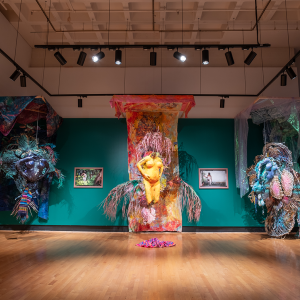Washington Post write-up: Exhibits highlight maternal themes past and present

Review by Mark Jenkins
December 1, 2023
Motherhood links two shows at the University of Maryland Art Gallery that overlap physically as well as thematically. The venue’s front room is devoted mostly to “African Art From the Dr. Gilbert and Jean Jackson Collection,” traditional pieces collected by a pair of university alumni. Coralina Rodriguez Meyer’s “Mother Molds” occupies the backroom, but a few of its pieces infiltrate the display of African works, so the artist’s casts of pregnant torsos complement the many sculptures of a mother and child.
The Jacksons’ holdings are largely from West Africa (including what is now Ivory Coast) and were mostly made in the 19th and 20th centuries. Some are undated but are probably of similar vintage. (Because such artworks are usually made of wood, few earlier ones survive.) The artists are unknown, and some objects may be the product of more than one pair of hands. But they have a strong sense of unity, in part because many were carved from a single block of wood.
The gallery can offer little definitive information on the African pieces, but they illustrate typical concerns. In addition to the mother-and-child figures, representing fertility and human continuity, the selection includes ancestor figures and masks made for ceremonial wear. They exemplify cultures in which spirituality sifts into everyday life.

